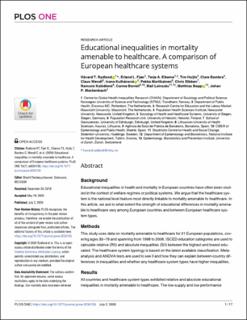| dc.contributor.author | Rydland, Håvard Thorsen | |
| dc.contributor.author | Fjær, Erlend Løvø | |
| dc.contributor.author | Eikemo, Terje Andreas | |
| dc.contributor.author | Huijts, T. | |
| dc.contributor.author | Bambra, C | |
| dc.contributor.author | Wendt, C | |
| dc.contributor.author | Kulhánová, Ivana | |
| dc.contributor.author | Martikainen, Pekka | |
| dc.contributor.author | Dibben, Chris | |
| dc.contributor.author | Kalediene, R | |
| dc.contributor.author | Borrell, Carme | |
| dc.contributor.author | Leinsalu, Mall | |
| dc.contributor.author | Bopp, Matthias | |
| dc.contributor.author | Mackenbach, Johan P. | |
| dc.date.accessioned | 2021-09-14T08:42:35Z | |
| dc.date.available | 2021-09-14T08:42:35Z | |
| dc.date.created | 2020-09-28T14:29:42Z | |
| dc.date.issued | 2020 | |
| dc.identifier.citation | PLOS ONE. 2020, 15 (7), . | en_US |
| dc.identifier.issn | 1932-6203 | |
| dc.identifier.uri | https://hdl.handle.net/11250/2776389 | |
| dc.description.abstract | Background
Educational inequalities in health and mortality in European countries have often been studied in the context of welfare regimes or political systems. We argue that the healthcare system is the national level feature most directly linkable to mortality amenable to healthcare. In this article, we ask to what extent the strength of educational differences in mortality amenable to healthcare vary among European countries and between European healthcare system types.
Methods
This study uses data on mortality amenable to healthcare for 21 European populations, covering ages 35–79 and spanning from 1998 to 2006. ISCED education categories are used to calculate relative (RII) and absolute inequalities (SII) between the highest and lowest educated. The healthcare system typology is based on the latest available classification. Meta-analysis and ANOVA tests are used to see if and how they can explain between-country differences in inequalities and whether any healthcare system types have higher inequalities.
Results
All countries and healthcare system types exhibited relative and absolute educational inequalities in mortality amenable to healthcare. The low-supply and low performance mixed healthcare system type had the highest inequality point estimate for the male (RII = 3.57; SII = 414) and female (RII = 3.18; SII = 209) population, while the regulation-oriented public healthcare systems had the overall lowest (male RII = 1.78; male SII = 123; female RII = 1.86; female SII = 78.5). Due to data limitations, results were not robust enough to make substantial claims about typology differences.
Conclusions
This article aims at discussing possible mechanisms connecting healthcare systems, social position, and health. Results indicate that factors located within the healthcare system are relevant for health inequalities, as inequalities in mortality amenable to medical care are present in all healthcare systems. Future research should aim at examining the role of specific characteristics of healthcare systems in more detail. | en_US |
| dc.language.iso | eng | en_US |
| dc.publisher | PLOS | en_US |
| dc.rights | Navngivelse 4.0 Internasjonal | * |
| dc.rights.uri | http://creativecommons.org/licenses/by/4.0/deed.no | * |
| dc.title | Educational Inequalities in Mortality Amenable to Healthcare. A Comparison of European Healthcare Systems | en_US |
| dc.type | Peer reviewed | en_US |
| dc.type | Journal article | en_US |
| dc.description.version | publishedVersion | en_US |
| dc.source.volume | 15 | en_US |
| dc.source.journal | PLOS ONE | en_US |
| dc.source.issue | 7 | en_US |
| dc.identifier.doi | 10.1371/journal.pone.0234135 | |
| dc.identifier.cristin | 1834332 | |
| dc.description.localcode | Copyright: © 2020 Rydland et al. This is an open access article distributed under the terms of the Creative Commons Attribution License, which permits unrestricted use, distribution, and reproduction in any medium, provided the original author and source are credited. | en_US |
| cristin.ispublished | true | |
| cristin.fulltext | original | |
| cristin.qualitycode | 1 | |

